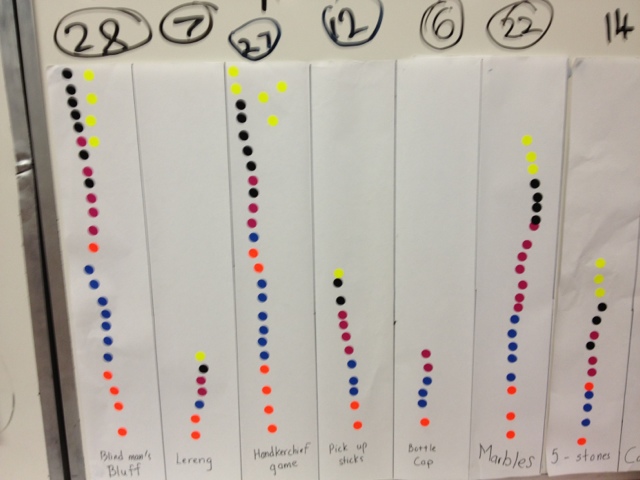July 11, 2013
Again, we were warmly welcomed by the staff as we arrived. Everyone has been so incredible!
First on our list of observation was a series of lessons where students are working on special projects for ePals (pen pal program). Through this website Gongshang has been paired up with a few schools around the world to connect the kids as ePals. Their special project is regarding traditional games- they will learn about their own culture's traditional games, make the materials, and lastly share them by shipping the materials and instructions to their partner school. Once they receive their package they will not only have learned about their own country's games but also of another. We are so trying this next year!!
Some great ideas we saw regarding this project were:
-Have students interview their parents for them to learn their own family's traditional games.
-Have students present their findings from the interview
-Play the games (most fun of course!)
-After playing: explain the rules in writing and evaluate which you like most
-Survey the class on their favorite game and create a bar graph (explained in detail below).
-Involve Math as you make the materials i.e measurement, counting, geometry
During these activities, students were extremely engaged and learning about their heritage!
One of the Math lessons we were able to watch in full involved the survey and bar graph of the class' favorite games. This was in a P3 classroom. Here are some notes of what we saw:
*T gives students a few dot stickers to vote on their favorite games on the chart the teacher had on the board (see picture below)
*Next T gives markers to kids to go count how many stickers are in each column, Sts write number above
*T analyzes the chart a bit with the kids just to see how they differ. She asked questions like: can you tell for sure that its more? Is our chart organized enough for you to see it visually? (Stickers were not aligned and did not match up from column to column).
*T defines a bar graph (reminds kids of a previous lesson)
*T says: "We can also ask questions about a bar graph". Asks a few students for examples- "which 2 have the same number?"
*Now T reminds the students that they have done the data collection together now they must organize it in a bar graph. T says she will provide the paper but students will have to decide in their groups how they will make their graph and especially what scale they will choose.
*T models how a 1 by 1 scale would not be advisable because their is not enough space. She adds "you must discuss as a group".
*Next Sts broke up into groups and were off to work. Many discusses intently about which scale they would use. Then most groups designated tasks to each team member to get it all done.
We were amazed at how well they worked together and the rich mathematical discussions they were having around graphing!!
*As groups finished T assigned then to think of questions they could ask their friend about the graph and write them on the back.
This lesson reminded us of the importance of group work and discussions. We saw a great deal of engagement as students were voting and making their graph. This is definitely a lesson we can do with our students!!!
Another Math lesson we observed was in a P1 classroom where the teacher used the smartboard to teach addition within 40. She used the number line, base 10 drawings, number bonds and the algorithm to show addition within 40. This variety of representations gave students many opportunities to learn the concept. It also a great way to warm the students up before getting to the content. See pictures below.
There was so much more we saw that day but its hard to include it all. Thank you to all the teachers that welcomed us into their classrooms.
We ended the day with some discussion time with a few of the teachers and here are some of the topics we touched on:
Q: How do you teach problem solving strategies?
A: SEAL acronym for procedure of problem solving (search, explore, apply, look back***very important). Also, using the Heuristics Approach (new topic to us) that involves a set of problem solving strategies you can use according to each kind of problem (ex model drawing, guess and check, working backwards...)
Each strategy is taught, student are encouraged to practice it that day and add it to their list of strategies. Later students have the ability to choose the strategy that makes the most sense to them and with that type of problem.
Q: How do you teach student to work in groups?
A: start working in groups from an early age, review rules every time, and assign roles (leader, timekeeper, speaker, secretary).
Q: What percentage of instruction involves group work?
A: About 40%, because of our number of students we must also do frontal teaching.
We were so thankful of all the time that the Gongshang teachers and administrators sat with us and answered all of our questions, because we had many!! :)
We also thank them for their hospitality, generosity and time!
Can't believe how much we have already seen and learned, and we are only half way! Next week we will be visiting 2 more schools...until then! :)
Realia- traditional games they have been talking about
Class graph
Counting up each column
Figuring out the scale
Final graph
One student referring to her textbook (Discovering Maths)
Sums lesson on the smart board (using base ten representations)
Sums (using number bonds)
Life size Sudoku- in the math room that students can use to play math games
Magnets on both sides
Picture with our wonderful hosts
Shay with all the goodies we got












No comments:
Post a Comment